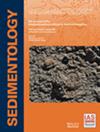澳大利亚西北大陆架浮游有孔虫中的双生白云石
IF 2.8
2区 地球科学
Q1 GEOLOGY
引用次数: 0
摘要
浮游有孔虫贝壳通过其微量元素和稳定同位素被广泛用于研究过去海洋和气候的变化。然而,这些地球化学方法可能会因成岩高镁方解石的存在而受到影响。本研究在澳大利亚西北大陆架(300 米)浅海环境中的国际大洋发现计划 U1464 号站点沉积物的浮游有孔虫中观察到了白云石晶体。本研究利用新的扫描电子显微镜、X 射线衍射、稳定同位素(碳和氧)、镁/钙和稀土元素数据,结合船上地球化学和现有文献,对白云石的形成进行了研究。研究发现,有孔虫白云岩的形成可能与早期成岩、微生物和老化过程有关。提出了两种潜在的成岩过程(海底成岩和沉积后成岩),这两种过程都表明白云石形成的有利氧化还原条件是低氧,这可能会激活甲烷催化作用,促进白云石的形成。据推测,在这种情况下,高镁方解石可能是有孔虫白云石的前体,而溶解-沉淀可能是白云石形成的老化过程。与更深、更正常的浮游环境相比,这项研究表明,海洋环境可以通过向海底输送更多有机物来促进白云石沉淀。本文章由计算机程序翻译,如有差异,请以英文原文为准。
Diagenetic dolomite in planktonic foraminifera on the Australian Northwest Shelf
Planktonic foraminiferal shells are widely used to investigate past oceanographic and climatic variations via their trace elements and stable isotopes. However, these geochemical methods may be compromised by the presence of diagenetic high‐Mg calcite. In this study, dolomite crystals are observed in planktonic foraminifera from International Ocean Discovery Program Site U1464 sediments on the Australian Northwest shelf, a shallow marine environment (<300 m). This study investigates the formation of the dolomite using new scanning electron microscopy, X‐ray diffraction, stable isotope (carbon and oxygen), Mg/Ca and rare earth element data, combined with shipboard geochemistry and available literature. This study finds that foraminiferal dolomite formation was probably associated with early diagenesis, microbial and ageing processes. Two potential diagenetic processes (seafloor diagenesis and post‐depositional diagenesis) are proposed, and both indicate that the favourable redox condition of dolomite formation is low oxygen, which may activate methanogenic catalysis to facilitate dolomite formation. It is postulated that high‐Mg calcite may be the precursor of foraminiferal dolomite in this case, and that dissolution–precipitation may be the ageing process of dolomite formation. In contrast to deeper, more normal pelagic environments, this study shows that the marine environment can facilitate dolomite precipitation by higher fluxes of organic matter to the seafloor.
求助全文
通过发布文献求助,成功后即可免费获取论文全文。
去求助
来源期刊

Sedimentology
地学-地质学
CiteScore
8.20
自引率
11.40%
发文量
94
审稿时长
6-12 weeks
期刊介绍:
The international leader in its field, Sedimentology publishes ground-breaking research from across the spectrum of sedimentology, sedimentary geology and sedimentary geochemistry.
Areas covered include: experimental and theoretical grain transport; sediment fluxes; modern and ancient sedimentary environments; sequence stratigraphy sediment-organism interaction; palaeosoils; diagenesis; stable isotope geochemistry; environmental sedimentology
 求助内容:
求助内容: 应助结果提醒方式:
应助结果提醒方式:


